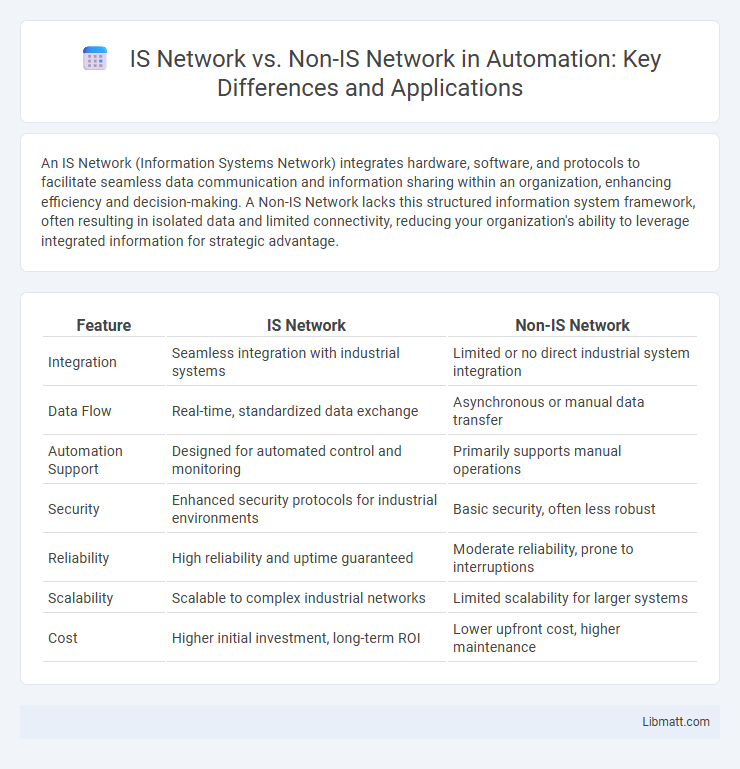An IS Network (Information Systems Network) integrates hardware, software, and protocols to facilitate seamless data communication and information sharing within an organization, enhancing efficiency and decision-making. A Non-IS Network lacks this structured information system framework, often resulting in isolated data and limited connectivity, reducing your organization's ability to leverage integrated information for strategic advantage.
Table of Comparison
| Feature | IS Network | Non-IS Network |
|---|---|---|
| Integration | Seamless integration with industrial systems | Limited or no direct industrial system integration |
| Data Flow | Real-time, standardized data exchange | Asynchronous or manual data transfer |
| Automation Support | Designed for automated control and monitoring | Primarily supports manual operations |
| Security | Enhanced security protocols for industrial environments | Basic security, often less robust |
| Reliability | High reliability and uptime guaranteed | Moderate reliability, prone to interruptions |
| Scalability | Scalable to complex industrial networks | Limited scalability for larger systems |
| Cost | Higher initial investment, long-term ROI | Lower upfront cost, higher maintenance |
Introduction to IS and Non-IS Networks
IS (Integrated Services) Networks prioritize the seamless transmission of voice, video, and data by reserving bandwidth and guaranteeing quality of service, ensuring reliable communication across various applications. Non-IS Networks, in contrast, operate on a best-effort basis without dedicated resource allocation, leading to variable performance and potential delays during high traffic. Your choice between IS and Non-IS Networks depends on the need for consistent, high-quality service versus cost-effective, flexible connectivity.
Defining IS Network: Key Characteristics
IS Network, or Information Systems Network, is characterized by its integration of hardware, software, and data resources to facilitate seamless information exchange across organizational units. It prioritizes data security, scalability, and real-time communication to support complex business processes and decision-making. Your enterprise benefits from an IS Network by enabling efficient resource management and comprehensive data analytics that drive competitive advantage.
Understanding Non-IS Network: An Overview
Non-IS Network refers to communication systems that do not utilize Intermediate System (IS) protocols, contrasting with IS Networks which rely on IS-IS for routing. These networks often depend on simpler, fixed routing methods or alternative protocols like OSPF or RIP to manage data traffic. Understanding Non-IS Networks helps you optimize infrastructure choices based on your specific scalability and complexity requirements.
Major Differences Between IS and Non-IS Networks
IS networks utilize intermediate systems to facilitate packet routing between different network segments, enhancing scalability and efficiency in large or complex infrastructures. Non-IS networks rely on end systems for routing without intermediate routers, which simplifies configuration but limits network size and resilience. Key differences include routing management, network scalability, and the ability to support dynamic path adjustments, with IS networks providing advanced path control and fault tolerance.
Security Standards in IS vs Non-IS Networks
IS networks follow stringent security standards such as ISO/IEC 27001 and NIST frameworks, ensuring robust data protection and risk management. Non-IS networks often lack these comprehensive protocols, making them more vulnerable to cyber threats and unauthorized access. Your organization benefits from enhanced confidentiality and integrity by adhering to IS network security standards.
Common Applications of IS and Non-IS Networks
IS networks are commonly used for mission-critical applications such as banking, telecommunications, and enterprise resource planning where secure, reliable data transmission is essential. Non-IS networks often support less sensitive tasks including basic internet browsing, email communication, and casual file sharing, prioritizing accessibility over stringent security measures. Your organization's choice between these networks depends on the sensitivity and critical nature of the applications it supports.
Compliance and Regulatory Considerations
IS Networks must adhere to stringent compliance frameworks such as HIPAA, PCI DSS, and GDPR, ensuring robust data protection and regulatory alignment. Non-IS Networks face fewer regulatory burdens but may lack comprehensive security controls, increasing the risk of non-compliance penalties. Effective governance in IS Networks involves continuous monitoring, auditing, and incident response strategies tailored to regulatory mandates.
Advantages and Limitations of IS Networks
IS Networks offer advantages such as efficient data integration, enhanced communication protocols, and improved scalability for large-scale enterprise systems. These networks enable seamless information sharing and centralized management, which can optimize your organization's operational efficiency. Limitations include higher implementation costs, increased complexity, and potential vulnerability to security breaches if not properly managed.
Benefits and Drawbacks of Non-IS Networks
Non-IS networks, lacking an integrated information system, offer simplicity and lower initial costs, making them accessible for small-scale or isolated operations. However, they pose challenges in scalability and data consistency, as manual processes increase the risk of errors and reduce operational efficiency. Limited automation and slower information flow hinder real-time decision-making compared to IS networks optimized for connectivity and data integration.
Choosing the Right Network for Your Organization
Selecting the right network for your organization depends on understanding the fundamental differences between IS networks, which integrate Information Systems for seamless data management and enhanced security, and Non-IS networks that primarily focus on basic connectivity without advanced data processing capabilities. IS networks offer scalable solutions with improved operational efficiency, making them ideal for organizations prioritizing data-driven decision-making and robust information exchange. Evaluate your organization's need for real-time data access, security protocols, and integration capabilities to determine whether an IS or Non-IS network will optimize your infrastructure performance and support your business objectives.
IS Network vs Non-IS Network Infographic

 libmatt.com
libmatt.com